Aunt Bertha: Innovation in Social Work
Have you heard of Aunt Bertha? Aunt Bertha is an innovative program makes it easy for both advocates and people in need to find food, health, housing and education programs in just a few clicks via the web.
This week, I had the pleasure of interviewing Erine Gray, a government consultant, who didn’t like business as usual in the Human Services field and set out to make a difference!
Erine, What led you to establish Aunt Bertha?
Aunt Bertha was an idea that took ten years, but it started with my mom. I became my mother’s guardian in 2002. In 1992 she had brain damage as a result of a bad case of Encephalitis. She lost most of her memory. I was 17 years old at the time and she came home from the hospital not knowing my name. My dad took care of her for a long time, but he got sick too and couldn’t continue – she needed 24-hour care.
Through that experience I came to understand the lack of services available for severely ill, especially if you’re low-income. There is a gap, a huge gape, and caretakers, like my family, are left with little options. We have tons of great programs, but access and service is still low in some places.
An example of Aunt Bertha indicating program availability
From the experiences with my mom, I got to know a couple of social workers and I was so impressed. They were very real with me about the situation, my options but they delivered news in such a way that made me feel that they understood what I was going through. I have no doubt that they did know what I was going through. In they end they helped my mom get into a situation where she could improve. And she did.
I spent 4 years improving access to human services as a consultant for the State of Texas. I read reports, analyzed business processes and implemented improvements. Many nights, I would listen to calls from the neediest Texans looking for help.
I could feel the pain and desperation on the other end. I learned that the process for finding and applying for services is hard work, too complicated, and did not serve client. Listening to those calls, I became convinced that people wanted to help themselves.
I believe they wanted to be able to help themselves and find answers, but the tools provided by the government were/are poorly designed.
One of my projects was to redesign the IVR (interactive voice response) and it was a rewarding experience. I was able to implement a new process making things a lot easier, 10% of our callers were able to get what they wanted so much faster, almost immediately, without having to burn their cell phone minutes.
What is it about Aunt Bertha that makes it different from other social programs?
Our mission is to make human service information easy to find and access. We build algorithms that help people find programs and help organizations have simpler reporting tools. All the programs are all in one place, a person can access a job training program, a food pantry, and mental health services in a matter of seconds over the web.
The three ways that we are trying to do business differently is:
1) Ease of Use: As a former government consultant I know how complicated applications, descriptions, and programs can be. I have hired someone to change program descriptions to be easy enough that a middle-schooler could read, but with extensive information like who to call and when.
2) Matching: The forms are too long because of evaluation and funding. We ask simple questions that make it easy for a busy social worker to help someone find information fast and a potential user can see what program they qualify for, and for how much in seconds.
3) Consistency: Working with social workers, agencies, and schools across the country we plan on constantly updating our database and taking suggestions which makes our information always fresh and accurate. You would no longer have to worry about wrong numbers and addresses.
Who is Aunt Bertha and where did this name come from?
I wanted the opposite of Uncle Sam. Imagine the crazy aunt we all had growing up. She’s the aunt who never forgets your birthday.
She’s also the one who will blurt out that the turkey is dry at Thanksgiving! She tells it like it is, but at the end of the day, she’s the one we go to when we’re in trouble.
Because we are organizing all of the federal, state and local government programs, Aunt Bertha picks up where Uncle Sam leaves off. I picked Bertha because I wanted something that makes you smile and that people will remember.
How long has Aunt Bertha been in existence and where does it get its financing from?
I am a creative writer, and have always wanted to lock myself in a cabin and write the great American novel. In fact, I was saving for just that until the idea of Aunt Bertha struck me. After some soul-searching I decided to start the company using my savings. I’ve financed 100% of the operation myself.
The good news is that because I used to be a programmer I was able to update my skills and write all of the software and do most of the design myself, which is the most expensive part of starting a software company. It’s funny because I gave away most of my programming books years ago because I never thought I would need them again. Little did I know!
We’re trying to build a self-sustaining organization. To sustain ourselves in the future, we’d like to help governments and charities modernize their case management tools by offering affordable software that’ll help them better communicate with clients, drive down operational costs and allow better collaboration with other organizations.
How well distributed/available is Aunt Bertha throughout the United States? And how large of an operation is it? Update: It is now up and working throughout the U.S.!
We are still very early in our process and we have a thorough database in the Austin, TX area, which includes most of the larger charities and government programs. The site launched in early June and anybody can check it out if they’re curious. If they’re from outside of Central Texas, they can use 78702 as the zip code to get an idea of the user experience.
Our system is designed on the concept of a coverage area. So for nationwide programs, the coverage area is any zip code in the United States. This means that right now, anybody in the United States can see programs in their area.
As we add federal government programs in the coming weeks, they will be available live on the site, searchable anywhere in the United States. We will also be adding all of the state government programs of each state in the coming weeks.
We’ve designed the system as a platform so that anybody can suggest a program. We’re building out the business process and tools so that program information can get submitted, vetted and approved quickly. We’re building a community of volunteers to help build our nationwide database using standard crowd-sourcing techniques. We’re still a small operation, just four of us right now.
What is the likelihood of the population in need having computer access (to directly access your site)?
The digital divide is a rapidly changing and interesting subject. When researching this idea last year I found a study that was quite surprising. According to an FCC study in 2010, approximately 40% of households that make less than $20,000 per year have broadband access at home. We believe that number will continue to grow with more competition among cable and internet companies. Of course, community wireless initiatives will help decrease the digital divide (although they are heavily lobbied against, unfortunately).
In addition, we’re seeing an increase in the number of people with internet access on their phones. Google estimates approximately 500,000 new android phones activated every day (a 25% increase since March alone). Cell phone companies like Cricket Wireless are offering unlimited talk and internet phone plans with android phones, for around $45 – $55 per month.
We think more and more users are going to access our site on their phones in the future. Our site works on android now (it’s a little clunky), but we’ll be deploying a version this summer that is specifically designed for mobile browsers. I want Aunt Bertha to be a resource that will help people when they’re already out and about getting through their day, not just when they’re just at home.
Benefit amount example
Although we still have a way to go with the digital divide, I think the competition amongst cell phone and cable internet providers will continue to bring prices down so that the internet is more accessible to those in need.
When your program does take off and people in need are able to access this information directly, is it possible that it could lead to a situation in which less social workers are needed to assist those in need? Many social workers are employed in case management type positions…
We are actually hoping to work with social workers and case managers to help individuals and families reach their goals. Looking at the NASW Standards for case managers, Aunt Bertha does not have the capacity or qualifications to solve the layered issues that face the people that are seeking services. We believe that the magic of case management, social work, and human services is in the trusting relationships developed and not in the ability of a website.
Aunt Bertha can’t solve family conflicts, help someone through a death, or console a person who has recently lost their job after decades of service, these are complex human dynamics that require folks on the ground.
What Aunt Bertha provides is a platform that a human service provider can use as “homework” for a client and a tool that clients can use to be actively engaged in the change process. Aunt Bertha doesn’t solve problems, it points you in the direction of the people that do in an easy way.
What are your hopes or plans for Aunt Bertha’s future?
Gosh, great question. We want to provide a friendly face that someone can go to when they’re too afraid to tell anyone they’re in trouble. Any hour of the day, through any electronic device, they can come to Aunt Bertha and just leave feeling that there are good people out there eager to help them and they know exactly what they need to do next.
We want to help people be a little less anxious about their situation. If we can help catch people when the tough times begin and help connect them to great programs and professional social workers, that’s half the battle. At the end of the day, if we help people avoid that slope downward we’ve *more* than succeeded.
Finally, how can social workers, case managers, and non-profiteers help?
3 Ways:
1. Let’s Play and Talk : Check out Aunt Bertha and let’s have a conversation!
2. Add a program: Do you work with or know of a fantastic non-profit! Tell us about it!
3. Add us on facebook (www.facebook.com/auntbertha) and twitter (@berthausa).
Thanks so much, Erine, for having created and introduced us to Aunt Bertha, an innovative tool that has the potential to truly help social workers working on behalf of people in need of services.
What questions and/or thoughts come to your mind following this interview? Please share them below 🙂
Feb 2015 Update: Aunt Bertha now provides its helpful information throughout the entire United States!
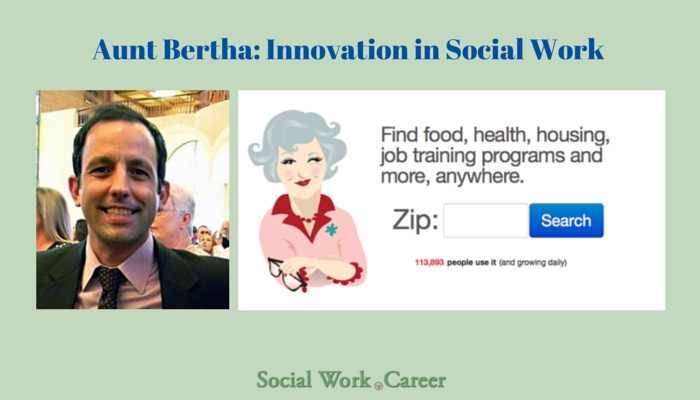
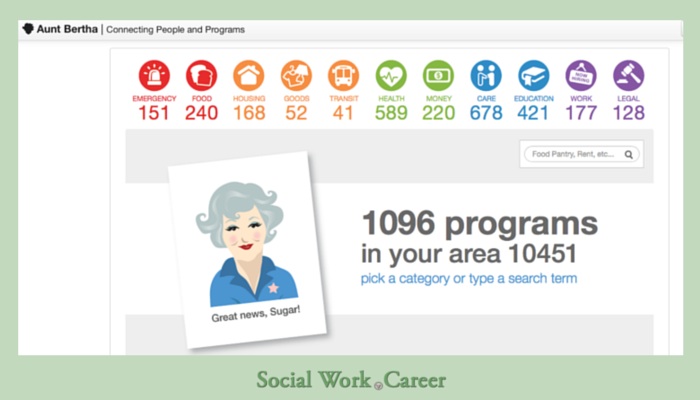
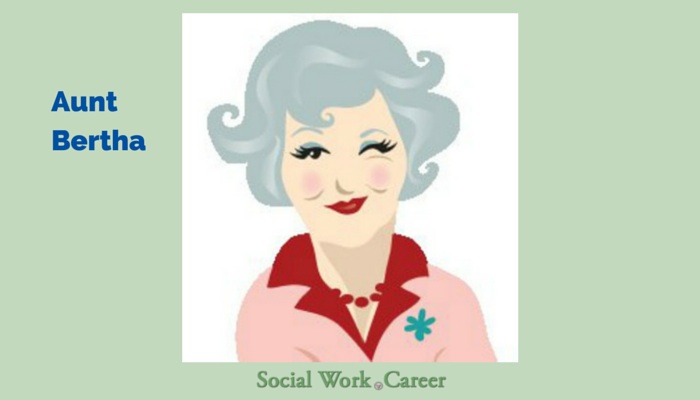
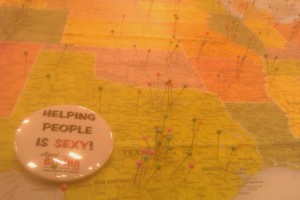
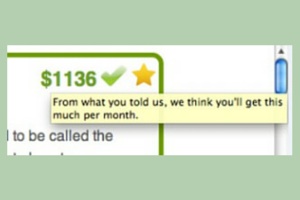


It’s wonderful to hear about this project! I am really excited to see such creative endeavors in the digital world that are initiated by social workers and other human services professionals.
We have something similar here in Buffalo that allow people to search for services and match on a variety of criteria–doesn’t include the means testing that I saw on Aunt Bertha–partly because that information can be pretty complex here and keeps shifting rapidly in this budget environment. But it uses some crowdsourcing (I think anyone can add a resource) and is used by providers and consumers. If you want to check it out it’s here: http://arounja.org/ Maybe you all could collaborate!
Thanks so much for the kind words!
I had heard about arounja.org recently – and it has a really good looking and friendly interface. It’s encouraging to see that they have been able to foster a crowd-sourced human service community. I’d love to work with them.
On a different note, I’m returning to upstate New York next week – visting my Dad in Olean. It’ll be just in time too, as I’m burning up down here in Texas. I really miss the Western New York summers.
Thanks again!
I get my hope from creative and innovative people who fight for what is right and just. This is a great example!! Love the idea of “Aunt Bertha” and I will definitely check out the sites mentioned. Thanks for sharing great information. (as always)
Thanks so much, Terry, for sharing your thoughts and for your kind feedback 🙂
Hi Terry–
Thanks a lot! We work in a fascinating industry-and I think we’re ready for new and creative technology solutions to help.
Although this information can be complicated to organize sometimes, we’re inspired by other industries who have worked hard to simplify the process.
We’d love any ideas for improvement if you think of any as well. Thanks so much!
Erine I’m sorry to tell you that we’re roasting here in Upstate and Western New York..at least by our definition! Safe travels on your visit to see your dad! One of our faculty members, Catherine Dulmus is from Olean and speaks of it fondly.
I love this idea. Electronic resources are much more convenient to access and are portable. Its annoying having to keep books and/or keep track of flyers. Clients who move frequently would appreciate feeling like they, literally, have access to them at their fingertips by way of phone or computer.
Hey “lifelovebalance”,
Your statement is definitely heard. Many government agencies are transitioning away from physical documentation, especially when its in the best service of the people who need these services.
We are hoping that as digital literacy increases adoption may spread for resources like Aunt Bertha that are at folks fingertips. If you have any other insights you like to share, definitely reach out backchannel mozart@auntbertha.com.
thanks again for the comment!
Nancy-
Olean was a great place to grow up. I went for a run tonight and it’s changed quite a bit over the last 20 years. You were right. It was warm.
Hopefully if you guys make to Austin, we can show you some good BBQ!
Take Care,
Erine
My BHHS 101 class at CCP had to do a report on Aunt Bertha, it was my first time hearing about the website.
It was an enjoyable experience-
I hope you visit our college one day
Chammelie
Hi Chammelie,
How wonderful that you wrote a report on Aunt Bertha for class!
I’d love to have the opportunity to visit your college one day 🙂
Best,
Dorlee